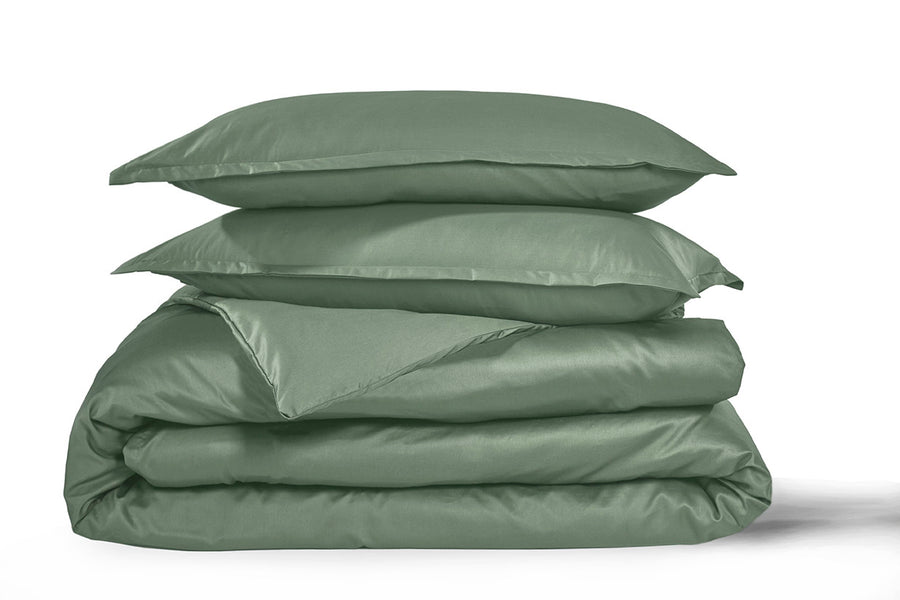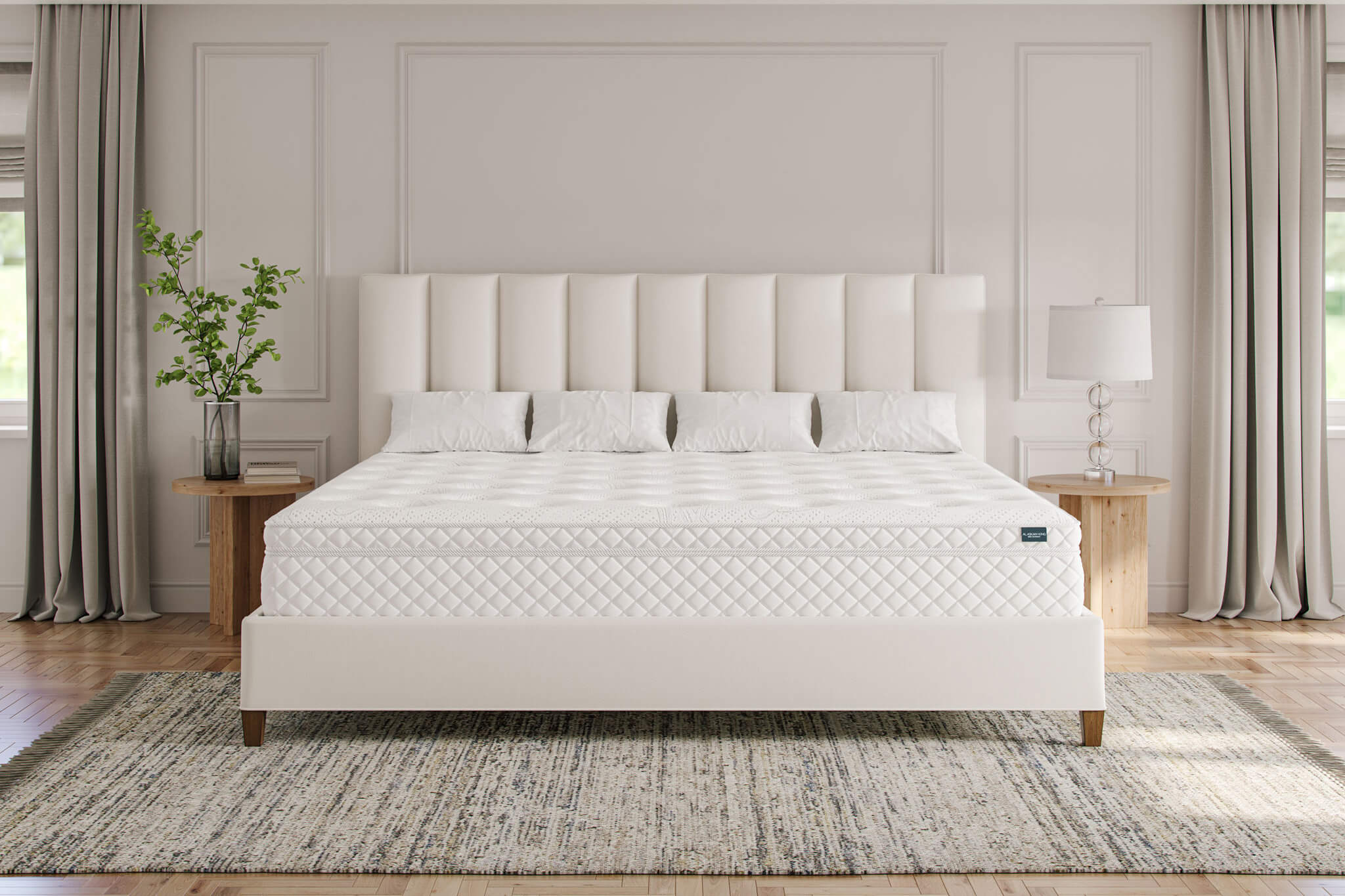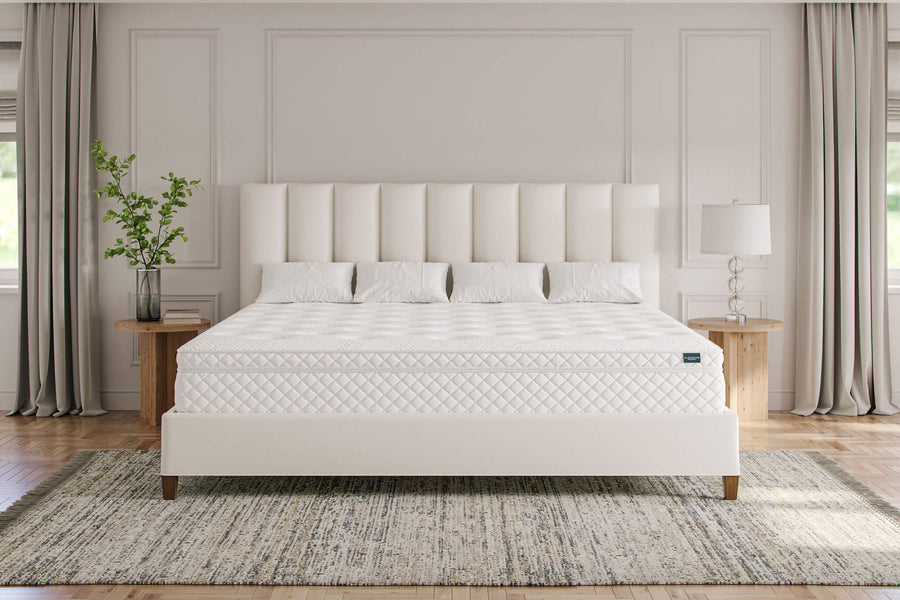Sleep Styles: The Ultimate Guide on the Best Positions for Sleeping
Finding the perfect sleeping position often feels like a nightly game of Twister where no one wins and everyone wakes up feeling tired. But poor sleep can do more than just make you cranky at the coffee machine.
It’s a slippery slope from tossing and turning to real health hiccups. Think mood swings at best and a Pandora’s box of health issues at worst. Yes, we’re talking bags under the eyes that could carry groceries, a memory as reliable as a weather forecast, and energy levels that barely keep you awake.
The good news is that everyone can get better quality sleep with a few lifestyle tweaks. The best place to start is your sleep position.

So, before you consider turning your bedroom into a laboratory for sleep experiments, let’s see why choosing the right sleep position could be the game-changer you’ve been snoozing on. We’ll also discuss the best sleep positions for specific conditions and co-sleeping.
What Is the Best Sleeping Position?
The best sleeping position usually involves sleeping on the side or the back because these positions better support your spinal alignment. That helps distribute body weight evenly, minimizing pressure on any area and allowing muscles to relax. In comparison, sleeping on your stomach can put more strain on your neck and back.
However, there isn’t a one-size-fits-all answer because the optimal sleeping position depends on many factors.
To get the most accurate answer, you should consider your health background, comfort preferences, sleep arrangements, and mattress quality.
So, let’s see the benefits and drawbacks of each sleep position to help you find the best one.
Sleeping on the Back
Many sleep experts tout back sleeping as the gold standard for a restful night. That’s because it has several health benefits, including:
- Spinal alignment: Sleeping on your back allows your spine, neck, and head to maintain a neutral position, reducing the risk of experiencing pains and aches.
- Reduced facial wrinkles: With your face not pressed against a pillow, there’s less chance of developing sleep-induced wrinkles. This could keep your skin smoother over time.
- Minimized acid reflux: When your head is elevated and aligned with your esophagus, gravity helps keep stomach acids in place, reducing the risk of acid reflux (provided your mattress and pillow offer the correct support).
- Even weight distribution: This position helps distribute body weight evenly across the widest surface of your body. This minimizes pressure points and contributes to more restful sleep.
However, keep in mind that sleeping on your back also has some drawbacks.
For example, it allows your tongue to fall back and block the airway, which can worsen snoring and other symptoms of sleep apnea.
In addition, sleeping on your back without proper support can lead to lower back pain due to excessive spine extension. That’s why it’s vital to have a high-quality mattress such as the Alaskan King.
Lastly, sleeping on the back isn’t recommended during pregnancy because it can put pressure on the back and abdomen and can reduce blood flow to the fetus.
This sleeping position is best for:
- People without snoring issues
- Individuals with acid reflux
- Skin-conscious sleepers
- People recovering from certain types of surgery
If you want to sleep on your back the right way, here are some recommendations:
- Ensure your pillow supports your head and neck without tilting your head forward or allowing it to fall back too far.
- Place a small pillow under your knees to maintain the natural curve of your lower back and reduce strain.
- If you have back pain, snoring, or sleep apnea, discuss with a healthcare provider to ensure back sleeping is suitable for you.
Sleeping on the Side
Sleeping on the side is the most popular sleeping position. In fact, people spend around 54% of their time sleeping on the side. Interestingly, older adults and people with higher body mass index (BMI) often prefer this position.
Here are the benefits of sleeping on the side:
- Snoring and sleep apnea: Greatly reduces snoring and is beneficial for those with obstructive sleep apnea, as it helps keep airways open.
- Digestive health: Sleeping on the left side can aid digestion and reduce acid reflux due to the alignment of the stomach and esophagus.
- Pregnancy: Highly recommended for pregnant women because it improves circulation to the heart, which is beneficial for both mom and baby.
- Back and neck pain: Can alleviate pain by maintaining the spine’s elongated and natural curvature.
However, sleeping on the side puts more pressure on the shoulder and hip, which can cause pain and numbness. In addition, it can worsen spine misalignments if you’re not careful about using proper support.
Another drawback is that pressing your face into a pillow can increase the risk of wrinkle formation and certain skin conditions.
So, overall, sleeping on the side is best for:
- People struggling with snoring and sleep apnea
- Pregnant women
- Anyone with acid reflux or digestive issues
Here are a few recommendations to help you get the best sleep in this position:
- Choose the right mattress firmness (too firm can lead to shoulder and hip pain, while too soft can result in spine misalignment).
- Make sure your pillow is firm enough to keep your head and neck aligned with your spine.
- Place a small pillow between your knees to reduce pressure on your hips.
- Switch sides throughout the night or over time to prevent overuse injuries or imbalances.
Sleeping on the Stomach
Experts don’t usually recommend sleeping on the stomach because it puts pressure on the internal organs and can potentially strain the neck and back. This is also the least favorite sleeping position among people, but it does have certain advantages:
- Reduced snoring: This position can keep the airways more open, which reduces snoring for some. However, it can make it worse for other people.
- Comfort: Stomach sleeping is simply the most effective way to fall asleep and the most comfortable position for some people.
Keep in mind that twisting the neck to the side can put a strain on the neck and spine, leading to potential discomfort and long-term issues. Lying on your stomach also puts extra pressure on your internal organs, which can affect breathing and circulation.
Lastly, pressing your face against a pillow is not the best idea for those who want to avoid wrinkles and keep their youthful appearance.
If you find that sleeping on your stomach gives you the most comfort, here’s how you can make the most of it:
- Use a thin or no pillow to reduce the angle at which your neck is turned.
- Place a pillow under the pelvis to maintain a more natural spine alignment.
- Invest in a supportive mattress with good cushioning to reduce the negative impact on your neck and back.
Best Sleeping Positions for Specific Conditions
|
Condition |
Best positions |
Additional tips |
|
Pregnancy |
Sleeping on the left side |
Use a pregnancy pillow for added support |
|
Sleep apnea |
Sleeping on the side |
Consider a CPAP machine or positional therapy with support from a healthcare provider |
|
Acid reflux |
Sleeping on the back or left side |
Elevate the head of the bed by 6-8 inches or use a wedge pillow |
|
Back pain |
Sleeping on the back or side |
Use a medium-firm mattress and pillow for knee support |
|
Neck pain |
Sleeping on the side with a pillow between the knees or back with a cervical pillow |
Choose a pillow that maintains the natural curve of the neck |
|
Shoulder pain |
Sleeping on the side with a pillow between arms or back sleeping with arm support |
Avoid sleeping on the affected shoulder and use supportive pillows to alleviate pressure. |
|
Congestion |
Sleeping on the back with an elevated head |
Use extra pillows to elevate the head and upper body for better sinus drainage |
What Is the Best Sleep Position to Sleep Together?
When sharing a bed, be it with a partner, kids, or even pets, the best sleep position is one that respects the comfort, preferences, and health needs of all bedfellows. The key is to have enough room for everyone to get comfortable, and a giant bed can provide just that.
For couples, finding a sleep position that suits both partners is crucial for a good night’s sleep and maintaining intimacy. Here are some positions you can try:
- The spoon: A classic for couples, where one person is the “big spoon” cradling the other. This position promotes a sense of security and closeness.
- Back-to-back: For those who value their space, sleeping back-to-back allows for individual comfort while maintaining a touch point at the back.
- The cradle: One partner lies on their back while the other rests their head on the partner’s chest. This position fosters a strong sense of protection and bonding.
If the whole family sleeps together, the rules change a bit. Here’s how you can make co-sleeping comfortable for everyone:
- Designate zones: Assign specific bed areas for each family member or pet to maintain order and ensure everyone has enough space.
- Put safety first: For young children, ensure they are positioned safely away from the edges and have adequate space to prevent accidental bumps during the night.
- Set pet boundaries: If pets sleep with you, consider using a pet bed within the larger bed or assigning a specific spot at the foot or side to keep everyone comfortable.
When sharing a bed, the most important thing is space. Space to stretch, turn, and find that perfect sleeping position. This is why so many families choose Alaskan King – it’s the biggest King size mattress on the market.
Here are a few additional tips to get comfortable on your giant mattress:
- Use individual bedding: Consider separate blankets or duvets to cater to different warmth needs and minimize disturbances.
- Invest in a quality mattress: Look for a mattress that minimizes motion transfer, which is crucial for not waking up your partner or child with every toss and turn.
- Use pillows strategically: Add extra pillows for support or use them as dividers in co-sleeping settings to provide a sense of individual space.
- Sync your sleep schedules: Try to align bedtime routines to minimize disruptions and enhance the sense of togetherness.
Unlock the Best Sleep Position With the Right Oversize Mattress
Finding your perfect sleep position is the shortcut to improving the quality of your rest and well-being. Although many experts recommend sleeping on the back because of the natural spine alignment, there is no universally best position for sleeping.
The truth is that the ideal sleep position is as personal as your dreams. It depends on your comfort preferences, body type, co-sleeping arrangements, and other factors.
However, one thing is universal – you need a mattress big enough to support your sleeping needs.
The Alaskan King bed is a place where you can explore, stretch out, and discover what feels right for you. It’s the perfect sleep sanctuary, offering personalized comfort and uninterrupted sleep.
Get an Alaskan King mattress and discover how easy it is to find a perfect sleeping position on a supportive and comfortable oversize bed.







